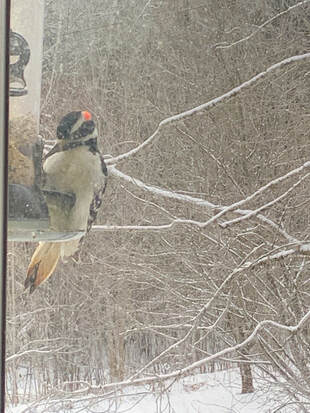
Lately, much of our entertainment has come from keeping the fire going in the woodstove and watching the bird feeders. We have two bird feeders up - once we did the initial winter fill, the birds took a little time to realize that the food was there and that it was not a trap. Since then, it's been a riot of birds and squirrels.
The chickadees came first. They were almost polite, taking turns at the feeder, while those not eating patiently waited in trees and bushes. But the chickadees were soon crowded out by finch size brown birds with whitish yellow breasts, a species that we have yet to identify, but whatever they are, they have no manners whatsoever. Six or more will perch on the feeder, crowding each other, even pecking at new arrivals, in a bid for a turn at one of the holes that lead to the birdseed.
We have two downy woodpeckers that have been visiting regularly. The large one, with a red head, dubbed Woody by my husband, is twice the size of the other. I personally have my doubts that they are the same species, but I have limited knowledge of birds. When Woody arrives, the smaller birds retreat to the snow-covered branches of the very large lilac bush near the feeder and watch angrily until Woody has eaten his fill.
Two blue jays have also been gracing us with their presence. We suspect that they are a couple. I checked on the web since, as stated above, I know nothing of birds, and discovered that male and female blue jays are indistinguishable by their feathers, and gender can only be determined by mating and nesting behaviors. However, when they mate, they mate for life. Jim and I have decided that this is a loving couple - whether it's true or not, a romantic story goes a long way in a cold winter. The blue jays, however, don't land on the bird feeders. They scramble for the seeds dropping on the ground underneath, competing with the squirrels. It seems that the squirrel proof feeders which we purchased do not fit the body size of bigger birds like jays. The small birds have no problem. The woodpeckers, perhaps because they are accustomed to twisting their bodies on tree trunks, manage as well.
The squirrels, though, are less than thrilled with having to make do only with seeds that drop from the small birds' frantic meals. Periodically, they try to scramble up the side of the house to figure some way onto the feeder. So far, they've had no luck. However, along with amusing us, the squirrels have sparked the interest of our 11-year-old cat, Xiao. They leap on the windowsill outside. Xiao leaps on the windowsill inside. The squirrels jump down and run for it. The squirrels probably know that he can't get out, but they're taking no chances.
The squirrels are a variety that I'm unfamiliar with as a former resident of Ohio, New York, and New Jersey. They are red with stubby, half-length tails. I keep wondering if all of them had some sort of accident - but it's probably a genetic thing. Perhaps squirrels with longer tails were more likely to be caught and consumed by the many predictors here in the Vermont woods. Or perhaps, other squirrels just found the shorter tails attractive. At some point, I'll research it. I'm not interested enough at this point.
We had two stale ends of whole grain bread, and Jim thought that perhaps the squirrels would like something more substantial than the occasional seeds. Yesterday afternoon, he tossed the bread into the snow close to, but not directly underneath the bird feeders. Then we hung out at windows for half an hour, waiting for the squirrels to discover and consume the bread. To our surprise, they were afraid of it, avoiding going near these strange and apparently foreboding objects. This morning when I rose, the bread was still there. I assumed, given the minus seventeen-degree temperatures, that the bread would be frozen solid and of no interest to wildlife at this point. However, when I checked on the birds and squirrels after spending some time working in my office, the bread was gone. I assume the squirrels either took it or consumed it so completely that nothing was left. Apparently, squirrels like frozen dinners.
It astonishes both Jim and me that the birds and squirrels can survive in such temperatures, although it probably explains what they are so frantically fighting for the birdseed. We did our part by filling the feeders before the weather went sub-zero, and we are probably feeding several dozen birds, maybe more, as well as three or four squirrels. But still, humans would not survive outside for long in this weather. That the birds and squirrels can do so seems nothing less than miraculous.
Today Jim and I are sticking close to the fire in our woodstove that supplements the central heating, and not venturing even a toe outside. We have a supply of food and wood that will get us through until temperatures rise to a more balmy 5 degrees or so. And we have books to read and to write to keep ourselves occupied. I'm busily editing Bloody Soil, the book I just finished writing which once again features my Russian Jewish secret agent, Kolya Petrov. Jim is working on his second book: his first will debut next November, the same month as Bloody Soil. In breaks from our fictional worlds, we will continue to marvel at the amazing spectacle outside our windows.
 RSS Feed
RSS Feed